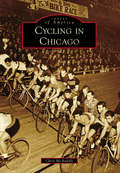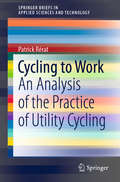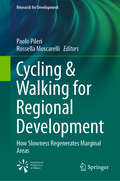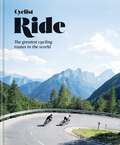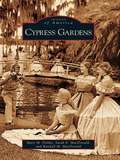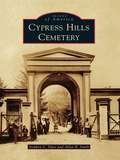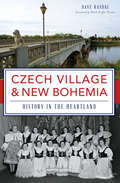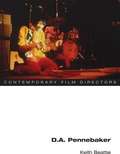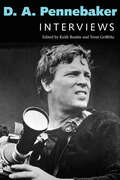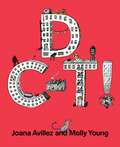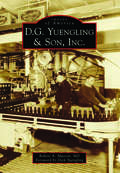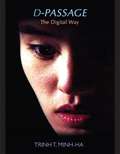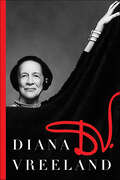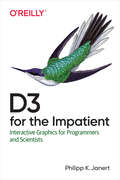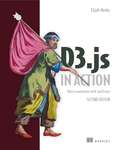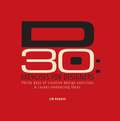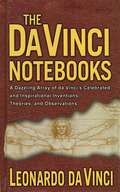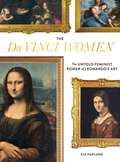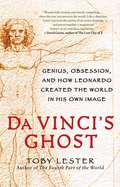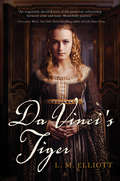- Table View
- List View
Cycling in Chicago (Images of America)
by Chris McauliffeIn the late 19th and early 20th century, Chicago was the center of bicycle manufacturing in the United States. As an early industrial and transportation center, two-thirds of all bicycles manufactured in the United States were from Chicago�it was the Detroit of bike manufacturing. For decades, Chicago was also a center for cycling track and road racing. Six-day races drew capacity crowds at the Chicago Stadium, Chicago Coliseum, and International Amphitheatre. Road and track competitions were also held at Sherman Park, the Humboldt Park Velodrome, and on Chicago�s famed Magnificent Mile. Today, Chicago is a hub for recreational cyclists. Hundreds of miles of bike lanes, rail to trails, and bike paths, such as the Illinois Prairie Path, the Bloomingdale Trail, Lakefront Path, and the Big Marsh, provide cyclists with numerous recreational and commuting options in a crowded urban environment. Chicago was awarded Bicycling Magazine�s Best Bike City of 2016.
Cycling to Work: An Analysis of the Practice of Utility Cycling (SpringerBriefs in Applied Sciences and Technology)
by Patrick RératThis book presents a thorough discussion of utility cycling, cycling in the urban environment, and everyday mobility. It is based on large survey answered by 14,000 participants in the bike to work action in Switzerland, and quantifies the various dimensions of utility cycling.It proposes an innovative theoretical framework to analyse and understand the various dimensions of the uses of bikes and their diversity. It addresses the factors that motivate commuters to get on their bike, and highlights the barriers to this practice between deficient infrastructures and lack of legitimacy. This research makes a diagnosis and discusses the way to develop this sustainable mode of transportation. By combining quantitative results in the form of tables, figures, and maps, and including qualitative results in the form of quotations from survey participants, this book provides a thorough and enjoyable read. It will be of interest to researchers, policy makers, advanced students in the field of urban planning, social sciences, and transportation.
Cycling & Walking for Regional Development: How Slowness Regenerates Marginal Areas (Research for Development)
by Paolo Pileri Rossella MoscarelliThis book investigates why and how cycle and walking paths can help to promote the regeneration of marginalized areas facing depopulation and economic decline. In addition, it offers a broad overview of recent scientific research into slow tourism and marginality/spatial inequality and explores the linkages between these topics. Key issues are addressed by experts from various disciplinary backgrounds, and potential measures are proposed for the integration of slow tourism into strategies for regional development. Particular attention is devoted to the VENTO project, which involves the creation of a 700-km-long cycle route from Venice to Turin that passes through various rural and marginalized areas of northern Italy. The goal, research process, design, and early lessons from this important project are all discussed in detail. Moreover, the book describes policies and strategies that have successfully been used to enhance the slow tourism infrastructure in other European countries. Given its scope, the book will appeal to researchers, professionals, and students interested in e.g. policymaking, tourism planning, regional development, and landscape and urban planning.
Cyclist – Ride: The greatest cycling routes in the world
by CyclistExplore 50 of the greatest, most thrilling road cycling routes the world has to offer, guided by the experts at the world's biggest road cycling magazine. Route maps, first-hand ride reports and truly breathtaking photography from the finest cycling photographers come together in this celebration of the world on two wheels.Covering the very best of Europe, from the twisting trails of northern Norway to the winding coast of southern Spain, this beautiful book also includes rides from as far afield as Vietnam, Ethiopia and Lebanon, as well as the USA.
Cyclist – Ride: The greatest cycling routes in the world
by CyclistExplore 50 of the greatest, most thrilling road cycling routes the world has to offer, guided by the experts at the world's biggest road cycling magazine. Route maps, first-hand ride reports and truly breathtaking photography from the finest cycling photographers come together in this celebration of the world on two wheels.Covering the very best of Europe, from the twisting trails of northern Norway to the winding coast of southern Spain, this beautiful book also includes rides from as far afield as Vietnam, Ethiopia and Lebanon, as well as the USA.
Cypress Gardens
by Mary M. Flekke Sarah E. Macdonald Randall M. MacdonaldFlorida's first theme park, Cypress Gardens, was the brainchild of Richard Downing Dick" Pope Sr. With his wife, Julie Downing Pope, he transformed a marshy, lakeside property in Winter Haven into a magnificent garden. The park's first visitors in 1936 toured pathways surrounded by lush plants from around the world. Two years later, electric boats meandered through the park's winding, hand-dug canals. Water ski shows commenced in 1942, and the park became the "Water Ski Capital of the World." The Florida-shaped Esther Williams Swimming Pool still graces the shore of Lake Eloise. The park was a set for dozens of short feature films, a stage for beauty pageants, and a site for special television broadcasts. A butterfly garden, zoo, rides, and the small-town Southern Crossroads shopping and dining area remain popular features. Kent Buescher purchased Cypress Gardens in 2004, and today's expanded Cypress Gardens Adventure Park preserves the family-friendly appeal of Dick and Julie Pope's magnificent park."
Cypress Hills Cemetery
by Stephen C. Duer Allan B. SmithFor the past 162 years, historic Cypress Hills Cemetery has quietly served thousands of New Yorkers and the public at large. This place of eternal rest obtained the distinct honor of being the first rural cemetery in Greater New York to be organized under the Rural Cemetery Act of 1847. Cypress Hills provides a perfect balance of lush landscaping, funerary art and sculpture, and a final resting place for some of America's most notable figures, such as Jackie Robinson, Mae West, and Eubie Blake. Carved on countless headstones are mysterious markings and secretive symbols that the living can ponder. Cypress Hills Cemetery illustrates and demystifies the various legends of those interred in these hallowed grounds.
Czech Village & New Bohemia: History in the Heartland (Brief History)
by Mark Stoffer Hunter Dave RasdalBeginning in the 1870s, thousands of Bohemians flocked to Cedar Rapids in search of a better life. Czech immigrants courageously overcame the difficult conditions of the local packinghouse and the challenge of creating a new home. They maintained a strong cultural identity with Czech music, literature and an undying dedication to family. In the wake of a devastating flood in 2008, the people of Czech Village and New Bohemia re-imagined traditional principles to forge a remarkable resurgence toward a promising future. Author Dave Rasdal travels from the Charles Bridge to the Bridge of Lions in a celebration of Czech heritage and history in Cedar Rapids.
D.A. Pennebaker (Contemporary Film Directors)
by Keith BeattieThis volume is the first book-length study of the extensive career and prolific works of D.A. Pennebaker, one of the pioneers of direct cinema, a documentary form that emphasizes observation and a straightforward portrayal of events. With a career spanning decades, Pennebaker's many projects have included avant-garde experiments (Daybreak Express), ground-breaking television documentaries (Primary), celebrity films (Dont Look Back), concert films (Monterey Pop), and innovative fusions of documentary and fiction (Maidstone). Exploring the concept of "performing the real," Keith Beattie interprets Pennebaker's films as performances in which the act of filming is in itself a performative transgression of the norms of purely observational documentary. He examines the ways in which Pennebaker's presentation of unscripted everyday performances is informed by connections between documentary filmmaking and other experimental movements such as the New American Cinema. Through his collaborations with such various artists as Richard Leacock, Shirley Clarke, Norman Mailer, and Jean-Luc Godard, Pennebaker has continually reworked and redefined the forms of documentary filmmaking. This book also includes a recent interview with the director and a full filmography.
D. A. Pennebaker: Interviews (Conversations with Filmmakers Series)
by Keith Beattie and Trent GriffithsThis wide-ranging and insightful collection of interviews with D. A. Pennebaker (b. 1925) spans the prolific career of this pioneer of observational cinema. From the 1950s to the present day, D. A. Pennebaker has made documentary films that have revealed the world of politics, celebrity culture, and the music industry. Following his early collaborations with Robert Drew on a number of works for television, his feature-length portrait of Bob Dylan on tour in England in 1965 (the landmark film Dont Look Back) established so-called direct cinema as a form capable of achieving broad theatrical release. With Monterey Pop, Pennebaker inaugurated the popular mode of rock concert film (or "rockumentary"), a style of filmmaking he has expanded on through a number of films, including Ziggy Stardust and the Spiders from Mars and Depeche Mode: 101.Pennebaker has always regarded collaboration as an integral part of his filmmaking methods. His long-running collaboration with Richard Leacock and subsequently his work with Chris Hegedus have enriched his approach and, in the process, have instituted collaboration as a working practice integral to American direct cinema. His other collaborations, particularly those with Jean-Luc Godard and Norman Mailer, resulted in innovative combinations of observational techniques and fictional aesthetics. Such films as The War Room, which was about the 1992 Democratic primaries and was nominated for an Academy Award, and the 2009 Kings of Pastry continue to explore the capacities of observational documentary. In 2012 Pennebaker was the first documentary filmmaker to be awarded an Academy Honorary Award by the Academy of Motion Picture Arts and Sciences.
D C-T!
by Joana Avillez Molly YoungA joy-inducing illustrated book about New York City in the ingenious style of William Steig's classic CDB!Just as there are few cities as storied and replete with life as New York City, there are few illustrators or writers who have charmed as many generations as William Steig. To Molly Young and Joana Avillez, a connection between the two seemed obvious, and so D C-T! ("The City!") was born.Using a playful phonetic language first invented by Steig in his now classic 1968 book CDB!--but which in today's world of text message and internet shorthand feels uncannily contemporary--Young and Avillez tell a different story on each page of this collection of illustrations stuffed to brim with humor and cleverness:"S L-I-F!" (It's alive!) A boy shouts gleefully at a pile of rubbish seething with rats"I M B-Z" (I'm busy) Declares the phone-wielding businesswoman to the would-be mugger"R U I?" (Are you high?) Asks the clerk at a bodega to the blissed out shopperBrought to life in Avillez's distinctively ebullient and droll style are precocious pets and pet-owners, iconic architecture, and startlingly intrepid anthropomorphic rats. At once recognizable, and imagined like never before, are the surprising, intoxicating, and not-always-entirely-welcome sights, sounds, and smells of New York City. Full of wit, romance, and sheer delight, D C-T! is both an affectionate portrait of the visual cornucopia that is New York City and a gracious love letter to the great William Steig, sure to enchant readers young and old alike just as his work has for half a century.
D.G. Yuengling & Son, Inc.
by Robert A. Musson Dick YuenglingKnown as "America's Oldest Brewery," D. G. Yuengling & Son, Inc., of Pottsville has been in continuous operation since 1829. Since its start, Yuengling has been prudently managed by the Yuengling family. Overcoming the 14 dry years of Prohibition, Yuengling persevered due in part to the ingenuity and creativity of its owners and loyalty of its consumers. Unlike many of the regional brewers who were forced to close their doors over time, Yuengling found a niche for itself beginning in the late 1980s. With the introduction of Yuengling Lager and Black & Tan, the brand became a sensation in and around Philadelphia. Popularity of the beverages led to Yuengling being distributed in 14 states, making it the largest American-owned brewery. Through more than 220 historic images, D.G. Yuengling & Son, Inc., tells the story of this legendary American company.
D-Passage: The Digital Way
by Minh-ha T. TrinhD-Passage is a unique book by the world-renowned filmmaker, artist, and critical theorist Trinh T. Minh-ha. Taking as grounding forces her feature film Night Passage and installation L'Autre marche (The Other Walk), both co-created with Jean-Paul Bourdier, she discusses the impact of new technology on cinema culture and explores its effects on creative practice. Less a medium than a "way," the digital is here featured in its mobile, transformative passages. Trinh's reflections shed light on several of her major themes: temporality; transitions; transcultural encounters; ways of seeing and knowing; and the implications of the media used, the artistic practices engaged in, and the representations created. In D-Passage, form and structure, rhythm and movement, and language and imagery are inseparable. The book integrates essays, artistic statements, in-depth conversations, the script of Night Passage, movie stills, photos, and sketches.
D.V.
by Diana Vreeland“An evening with D.V. is almost as marvelous as an evening with D.V. [herself]—same magic, same spontaneity and, above all, never a boring moment.”—Bill BlassD.V. is the mesmerizing autobiography of one of the 20th century’s greatest fashion icons, Diana Vreeland, the one-time fashion editor of Harper’s Bazaar and editor-in-chief of Vogue, whose incomparable style-sense, genius, and flair helped define the world of haute couture for fifty years. The incomparable D.V. proves herself a brilliant raconteur as she carries the reader along on her whirlwind life—from English palaces to the nightclubs of Paris in the 1930s to the heart of New York high society, hobnobbing with everyone who was anyone, from Queen Mary to Clark Gable to Coco Chanel.
D3 for the Impatient: Interactive Graphics for Programmers and Scientists
by Philipp K. JanertIf you’re in a hurry to learn D3.js, the leading JavaScript library for web-based graphics and visualization, this book is for you. Written for technically savvy readers with a background in programming or data science, the book moves quickly, emphasizing unifying concepts and patterns. Anticipating common difficulties, author Philipp K. Janert teaches you how to apply D3 to your own problems.Assuming only a general programming background, but no previous experience with contemporary web development, this book explains supporting technologies such as SVG, HTML5, CSS, and the DOM as needed, making it a convenient one-stop resource for a technical audience.Understand D3 selections, the library’s fundamental organizing principleLearn how to create data-driven documents with data bindingCreate animated graphs and interactive user interfacesDraw figures with curves, shapes, and colorsUse the built-in facilities for heatmaps, tree graphs, and networksSimplify your work by writing your own reusable components
D3.js 4.x Data Visualization - Third Edition
by Swizec Teller �ndrew RininslandCreate and publish your own interactive and compelling data visualizations with D3.js 4.x About This Book • Build interactive and rich graphics and visualization using JavaScript`s powerful library D3.js • Learn D3 from the ground up, using the all-new version 4 of the library • Gain insight into producing high-quality, extensible charts and visualizations using best practices such as writing testable, extensible code and strong typing Who This Book Is For This book is for web developers, interactive news developers, data scientists, and anyone interested in representing data through interactive visualizations on the Web with D3. Some basic knowledge of JavaScript is expected, but no prior experience with data visualization or D3 is required to follow this book. What You Will Learn • Map data to visual elements using D3's scales • Draw SVG elements using D3's shape generators • Transform data using D3's collection methods • Use D3's various layout patterns to quickly generate various common types of chart • Write modern JavaScript using ES2017 and Babel • Explore the basics of unit testing D3 visualizations using Mocha and Chai • Write and deploy a simple Node.js web service to render charts via HTML Canvas • Understand what makes a good data visualization and how to use the tools at your disposal to create accurate charts In Detail Want to get started with impressive interactive visualizations and implement them in your daily tasks? This book offers the perfect solution-D3.js. It has emerged as the most popular tool for data visualization. This book will teach you how to implement the features of the latest version of D3 while writing JavaScript using the newest tools and technique You will start by setting up the D3 environment and making your first basic bar chart. You will then build stunning SVG and Canvas-based data visualizations while writing testable, extensible code,as accurate and informative as it is visually stimulating. Step-by-step examples walk you through creating, integrating, and debugging different types of visualization and will have you building basic visualizations (such as bar, line, and scatter graphs) in no time. By the end of this book, you will have mastered the techniques necessary to successfully visualize data and will be ready to use D3 to transform any data into an engaging and sophisticated visualization. Style and approach This book follows a tutorial-based approach in teaching the world's most powerful data visualization library, D3.
D3.js in Action: Data visualization with JavaScript
by Elijah MeeksSummaryD3.js in Action, Second Edition is completely revised and updated for D3 v4 and ES6. It's a practical tutorial for creating interactive graphics and data-driven applications using D3. Purchase of the print book includes a free eBook in PDF, Kindle, and ePub formats from Manning Publications.About the TechnologyVisualizing complex data is hard. Visualizing complex data on the web is darn near impossible without D3.js. D3 is a JavaScript library that provides a simple but powerful data visualization API over HTML, CSS, and SVG. Start with a structure, dataset, or algorithm; mix in D3; and you can programmatically generate static, animated, or interactive images that scale to any screen or browser. It's easy, and after a little practice, you'll be blown away by how beautiful your results can be!About the BookD3.js in Action, Second Edition is a completely updated revision of Manning's bestselling guide to data visualization with D3. You'll explore dozens of real-world examples, including force and network diagrams, workflow illustrations, geospatial constructions, and more. Along the way, you'll pick up best practices for building interactive graphics, animations, and live data representations. You'll also step through a fully interactive application created with D3 and React. What's InsideUpdated for D3 v4 and ES6Reusable layouts and componentsGeospatial data visualizationsMixed-mode renderingAbout the ReaderSuitable for web developers with HTML, CSS, and JavaScript skills. No specialized data science skills required.About the AuthorElijah Meeks is a senior data visualization engineer at Netflix.Table of ContentsPART 1 - D3.JS FUNDAMENTALSAn introduction to D3.js Information visualization data flow Data-driven design and interaction Chart components Layouts PART 2 - COMPLEX DATA VISUALIZATIONHierarchical visualization Network visualization Geospatial information visualization PART 3 - ADVANCED TECHNIQUES Interactive applications with React and D3 Writing layouts and components Mixed mode rendering
D30 - Exercises for Designers: Thirty Days of Creative Design Exercises & Career-Enhancing Ideas
by Jim KrauseInstructive and enlightening. Fun, too.D30 is a workout book. In addition to dozens of readily applicable tips, tricks and informational tidbits, D30 contains thirty exercises designed to develop and strengthen the creative powers of graphic designers, artists and photographers in a variety of intriguing and fun ways. What will you need to begin? Not much. Most of the book's step-by-step projects call for setting aside an hour or two, rolling up your sleeves and grabbing art supplies that are probably already stashed somewhere in your home or studio--things like pens, drawing and watercolor paper, India ink, paint, scissors and glue. Digital cameras and computers are also employed for several of the exercises but--and this should be welcome news to those readers who spend their days looking at computer monitors--the majority of the book's activities make use of traditional media to illuminate creative techniques and visual strategies that can be applied to media of all sorts. Thumb through the book (or look at the samples posted on JimKrauseDesign.com) and see for yourself!
D30 - Exercises for Designers
by Jim KrauseInstructive and enlightening. Fun, too. D30 is a workout book. In addition to dozens of readily applicable tips, tricks and informational tidbits, D30 contains thirty exercises designed to develop and strengthen the creative powers of graphic designers, artists and photographers in a variety of intriguing and fun ways. What will you need to begin? Not much. Most of the book's step-by-step projects call for setting aside an hour or two, rolling up your sleeves and grabbing art supplies that are probably already stashed somewhere in your home or studio--things like pens, drawing and watercolor paper, India ink, paint, scissors and glue. Digital cameras and computers are also employed for several of the exercises but--and this should be welcome news to those readers who spend their days looking at computer monitors--the majority of the book's activities make use of traditional media to illuminate creative techniques and visual strategies that can be applied to media of all sorts. Thumb through the book (or look at the samples posted on JimKrauseDesign.com) and see for yourself!
Da traditore a eroe: Il falsario di Vermeer che ha imbrogliato gli Olandesi e i Nazisti
by Lázaro DroznesL'incredibile storia di Han van Meegeren, il pittore olandese che ha prodotto i falsi di Vermeer, ha ingannato gli stessi olandesi, ne ha venduto uno a Herman Goering e alla fine ha dovuto confessare il suo crimine per salvarsi dalla pena di morte, accusato di alto tradimento. Dopo il processo è diventato un eroe nazionale per aver imbrogliato i nazisti. Queste confessioni furono un terremoto nella comunità pittorica dell'Olanda e del mondo intero, poiché le sue falsificazioni erano state accettate all'unanimità e, una di esse, il "Cristo in Emmaus", fu considerata il miglior Vermeer di tutte. Questa finzione, basata su eventi reali, ci porta a riflettere sul concetto di autenticità nell'arte e sulla validità dei concetti tradizionali di verità e bellezza: un dipinto non è più bello quando viene scoperto come falso? Perché le persone perdono interesse per un'opera d'arte se non è autentica? Perché la natura umana non ci permette di godere dell'estetica di un falso Vermeer che ci piaceva prima di scoprire che fosse un falso? Il business dell'arte è una bufala?
Da Vinci (Getting to Know the World's Greatest Artists)
by Mike VeneziaA simple biography of Leonardo de Vinci for younger readers
The Da Vinci Notebooks: A Dazzling Array of da Vinci's Celebrated and Inspirational Inventions, Theories, and Observations (Text Connections Ser. #2)
by Emma DickensTowering across time as the creator of the Mona Lisa, forever famous as a sculptor and inventor, Leonardo da Vinci was one of the greatest minds of both the Italian Renaissance and Western civilization. His keen scientific imagination and, most of all, his aesthetic and creative genius have forever changed the course of our culture. Dan Brown's The Da Vinci Code and recent in-depth biographies have stimulated renewed interest in da Vinci and his complex and inquiring intelligence. He is a challenging figure easily defined only by his great works, but this revealing selection of sketches, diagrams, and writings from his notebooks is a beautiful and varied record of da Vinci's theories and observations. They embrace not only art but also architecture, town planning, engineering, naval warfare, music, medicine, mathematics, science, and philosophy. The notebooks-a treasure trove of unparalleled ingenuity, curiosity, and creative energy-have inspired readers for centuries. The Da Vinci Notebooks is the perfect introduction to the mysteries of a master artist.
The Da Vinci Women: The Untold Feminist Power of Leonardo's Art
by Kia VahlandThis new biographical look at Leonardo da Vinci explores the Renaissance master's groundbreaking portrayal of women which forever changed the way the female form is depicted. Leonardo da Vinci was a revolutionary thinker, artist, and inventor who has been written about and celebrated for centuries. Lesser known, however, is his revolutionary and empowering portrayal of the modern female centuries before the first women's liberation movements. Before da Vinci, portraits of women in Italy were still, impersonal, and mostly shown in profile. Leonardo pushed the boundaries of female depiction having several of his female subjects, including his Mona Lisa, gaze at the viewer, giving them an authority which was withheld from women at the time. Art historian and journalist Kia Vahland recounts Leonardo's entire life from April 15, 1452, as a child born out of wedlock in Vinci up through his death on May 2, 1519, in the French castle of von Cloux. Included throughout are 80 sketches and paintings showcasing Leonardo's approach to the female form (including anatomical sketches of birth) and other artwork as well as examples from other artists from the 15th and 16th centuries. Vahland explains how artists like Raphael, Giorgione, and the young Titan were influenced by da Vinci's women while Michelangelo, da Vinci's main rival, created masculine images of woman that counters Leonardo's depictions.
Da Vinci's Ghost
by Toby LesterEverybody knows the image, but nobody knows its story. In 1490, Leonardo da Vinci produced his iconic drawing of a man inscribed in a circle and a square: Vitruvian Man. Today the image appears on everything from coffee cups and T-shirts to corporate logos and spacecraft, and has become the world's most famous cultural icon. Yet few people know anything about it. In this remarkable book, Toby Lester, the author of the award-winning Fourth Part of the World, tells the picture's story, weaving together a saga of people and ideas that sheds surprising new light on the life and work of Leonardo, one of history's most fascinating figures.godlike perspective of the world's makeup. Da Vinci's Ghost captures a pivotal time in the history of Western thought, when the Middle Ages was giving way to the Renaissance, when art and science and philosophy all seemed to be converging as one, and when it seemed possible, at least to Leonardo da Vinci, that a single human being might embody--and even understand--the nature of everything.
Da Vinci's Tiger
by L. M. ElliottFor fans of rich and complex historical novels like Girl with a Pearl Earring or Code Name Verity, Laura Malone Elliott delivers the stunning tale of real-life Renaissance woman Ginevra de' Benci, the inspiration for one of Leonardo da Vinci's earliest masterpieces. The young and beautiful daughter of a wealthy family, Ginevra longs to share her poetry and participate in the artistic ferment of Renaissance Florence but is trapped in an arranged marriage in a society dictated by men. The arrival of the charismatic Venetian ambassador, Bernardo Bembo, introduces Ginevra to a dazzling circle of patrons, artists, and philosophers. Bembo chooses Ginevra as his Platonic muse and commissions a portrait of her by a young Leonardo da Vinci. Posing for the brilliant painter inspires an intimate connection between them, one Ginevra only begins to understand. In a rich and vivid world of exquisite art with a dangerous underbelly of deadly political feuds, Ginevra faces many challenges to discover her voice and artistic companionship--and to find love.
